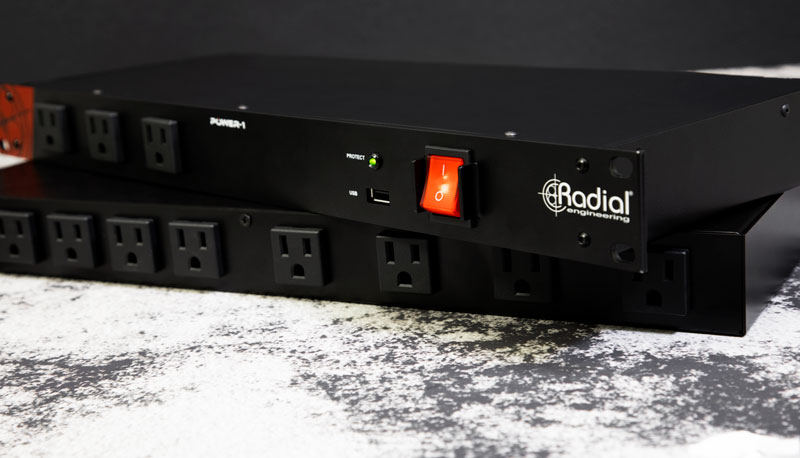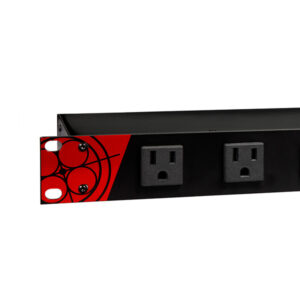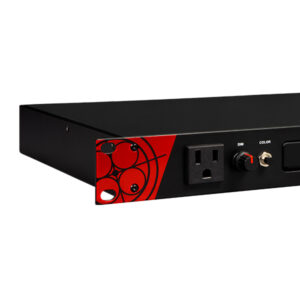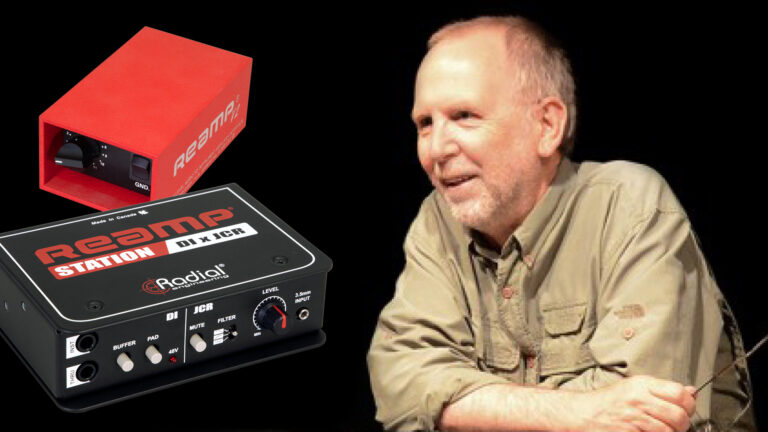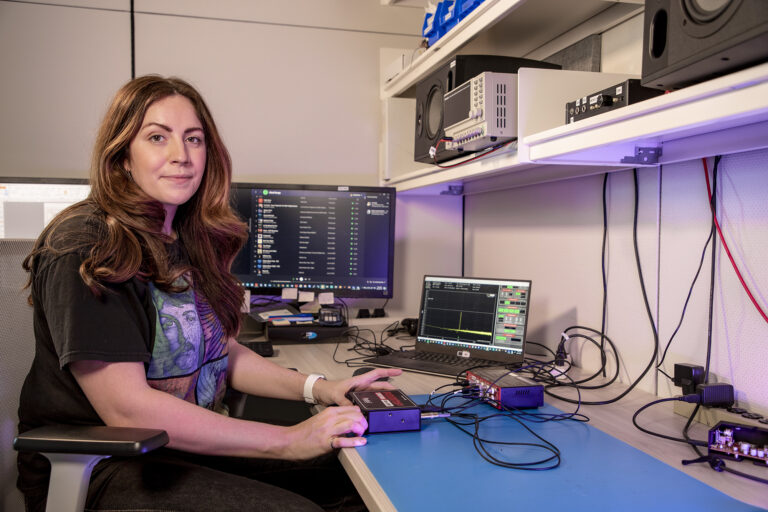Bill Whitlock, former President and Chief Engineer of Jensen Transformers Inc., has had decades of experience in keeping signals clean for audio transformers and power conditioners. He has written the book on solving ground loops and interference in many AES publications. Now he has taken the lead in designing the Radial Power Series. Recently, we got the chance to discuss some common audio issues and how Radial Power can make your system sound its best.
Radial: Let’s start with the source of hums and buzzes in a system. Is the power line generally the source?
Bill: This is sometimes true. You can’t argue with the fact that, if the power line wasn’t there, there wouldn’t be any of these noises if everything ran on batteries and never plugged in. But as long as we have things that plugin, the power line itself is the root source of the noises. However, much of the source of buzz and hum falls on the equipment itself. So I’d say it’s about 50/50. Power lines can be excessively noisy, true, but more and more equipment is using switching power supplies and wireless, so it’s not just the power line anymore.
Radial: What’s the source of this buzz and noise?
Bill: The air is full of radio frequencies and all kinds of radiated signals. Also, the power line is full of interference. It’s not just pure 60-cycle AC. Let’s use the analogy of a highway. We could have glass-smooth highways and it would require almost nothing in the way of suspension on a car. And if you think of your car and the smooth ride as being a noise-free signal, it’s riding along and being powered by this less-than-perfect highway.
Radial: So how do you cure the noise problem on this audio highway?
Bill: There are two ways to cure the noise problem. You can either make the highways glass smooth. In other words, get all this trash off the AC power. Or you can tolerate normal roads that have the occasional bumps and whatever by putting incredibly good suspension on your car. I call it the Cadillac syndrome, moving without the feeling of moving, as Cadillac owners like to think.
Radial: Does the building structure itself have any influence on noise and buzz?
Bill: Yes. I wrote a paper for the AES back in 2011 titled “Power Line Noises: The Rest of the Story.” It turns out that there is a coupling mechanism that is inadvertently designed into the way buildings are wired. It has to do with the fact that equipment almost always uses the ground conductor or that third pin on the outlet as a reference point. It’s primarily there for safety, but it inescapably gets involved in signals, because the chassis and the ground connection of all audio connectors have to be tied to the chassis for safety purposes. So if there’s noise on the ground conductor, it becomes a threat to the signal. And equipment interfaces, like balanced interfaces, are theoretically able to completely reject any of this noise. But in the real world and to save money, manufacturers use less than perfect balanced interfaces.
Radial: So this means that noise rejection in those devices is not as good as it could be?
Bill: Yes, in some devices, noise rejection is not as good as it might be. And of course, unbalanced interfaces, the RCA connector or the quarter-inch tip sleeve connectors, have a built-in high vulnerability to noise. It’s just part of the scheme. That’s why balanced connections exist. Professionals get tired of trying to deal with all the noise of RCA cables and all that stuff. So, for this reason, consumer gear has a built-in sensitivity issue.
Radial: So what can be done about AC power noise?
Bill: Well, pretty much the only thing you can do because most of this noise occurs at frequencies higher than 60 hertz, is apply filters. For example, a low pass filter passes low frequencies and attenuates any noises or frequencies that are above the cutoff frequency of the filter. Now, this has its limitations, but it is sometimes very effective at dealing with power supply noises, noises from fluorescent lights, and various high-frequency noises. The majority of those noises occur at frequencies of say 50 kilohertz or higher. And filters to stop those frequencies from entering the equipment are fairly small and not terribly expensive.
Radial: Is there a difference between buzz and hum in terms of the aspect of filtering?
Bill: Yes, buzz has quite a different character than hum. Hum would indicate that it’s almost purely a 60-cycle or 60-hertz thing. But the harmonics of 60 hertz, like the 10th harmonic, would be at 600 hertz and has an edgy higher frequency. So it’s really well imitated by just saying buzz and it’s very annoying. So those become extremely difficult to take out with filtering.
Radial: Is filtering a perfect solution to removing buzz and hum?
Bill: Unfortunately, no. Sometimes there’s just nothing else to do but to work on the interface and try to make it immune from buzz and hum. So filters are not the end-all of getting rid of noise.
Radial: Talk about the Radial Power-1 and Power-2 units with regards to filtering.
Bill: There’s a filter built-in to the Power-1 and Power-2 products. It’s an industry-standard filter that passes regulatory tests for safety, being flameproof, and being able to withstand high voltages, et cetera.
Radial: What do the filtering components in Power-1 and Power-2 have to do?
Bill: There’s a long list of things that the filters do. But as you lower the frequency of a filter and try to get down to where you could actually eliminate some of the buzz from the power line itself, the components in a filter, the inductors and capacitors involved, become very large and very expensive. Something that would filter out all the buzz components, starting with maybe the third or fifth harmonic of 60-cycle, would be as large as a refrigerator and it would cost thousands of dollars, so nobody does that. That said, the filters in Power-1 and Power-2 will get rid of things like AM radio stations, which may be radiating into the power line.
Radial: What type of filter attenuation do the Radial Power-1 and Power-2 offer?
Bill: In both, the attenuation starts at around 40 or 50 kilohertz, and certainly extends up past 20, 30 megahertz, somewhere in that region. This means it even filters out signals like ham radio and citizens band radio, which are very frequent. That said, the usual offender is local AM radio stations that come in. Power-1 and Power-2 are very good at those frequencies.
Radial: Talk a little more about the design of Power-1 and Power-2.
Bill: The primary function of Power-1 and Power-2 is surge protection and safety. The filtering is a secondary function, but both offer filtering as well.
Radial: What’s the primary difference between the Radial units and competitors?
Bill: A big difference between Power-1 and Power-2 and their competitors is the high-quality MOV we use.
Radial: What is a MOV?
Bill: MOV stands for Metal Oxide Varistor, and they’re made out of various zinc oxides, crystallized, and have electrodes plated on. So they have semiconductor properties. What happens is that the MOV starts drawing a small amount of current all the time, even though it’s operating below its rated threshold voltage, where it should start conducting current. It’s not supposed to draw any current at lower voltages, but a low-quality one or one that has really seen a lot of service hits will gradually deteriorate by lowering the threshold voltage.
Radial: How can you tell when this happens?
Bill: They start drawing enough current to actually get physically warm. It gets warmer and warmer and unfortunately, there’s a negative relationship between heat and threshold voltage. So the hotter it gets, the lower its threshold voltage gets, and it draws more and more current. It’s an escalating, runaway condition, so it gets worse, and worse, and worse the hotter it gets. And eventually, it’ll smoke and sizzle and burst into flames.
Radial: For a home studio owner, this could be catastrophic!
Bill: In the past, there were times when people were on vacation and their little hardware store-bought UL strip is sitting quietly under their desk and “protecting” their computer. It catches on fire and they come back from vacation, and their house is burned to the ground.
Radial: Were regulations passed to address this?
Bill: Yes, UL recognized this is a problem. So now, MOVs are required to have a thermal cutoff switch so that when they reach a certain temperature, a little bimetal switch opens up and disconnects it from the circuit. So it’s only allowed to get to a certain level of heat and then it shuts off.
Radial: So did this fix the problem of cheap power strips bursting into flames?
Bill: Not entirely. Unfortunately, there’s a lot of the equipment sold in this country that does not have a UL Listed sticker. So it’s a buyer beware mentality.
Radial: In addition to the made-in-USA MOVs that differentiate the Radial Power units from others on the market, are there other differences people should be aware of?
Bill: Yes, another important differentiator with the Radial Power units is the fact that they do not contaminate the ground. This is something that’s a little tough to explain but there are a lot of surge suppressors that are advertised making it sound like not contaminating the ground is a plus. They will say it’s a three-mode suppressor design. Now, what that means is that they have put a MOV across the line, the line, and the neutral. And they put a second one between the line, the hot conductor, and the safety ground or the chassis. And they put a third one between the neutral, the other blade of the AC, and the chassis or the safety ground.
Radial: How does this differ for the Radial Power units?
Bill: In the Radial Power units, there’s one MOV that sits across the line with two blades. There’s no connection to ground. There’s a reason that it doesn’t need to be there. Because surges between either side of the AC power and safety ground can only originate because of the way code requires buildings to be wired. They can only originate inside the building. And the most dangerous surges are the ones that come from outside, like lightning.
Radial: So the biggest dangers for power surges come from outside.
Bill: Yes, such as lightning or fallen power lines. These can cause huge surges on AC power. Imagine a traffic accident that wipes out a telephone pole, and cuts it off at the ground. The pole falls over and some four, five, 10,000-volt power lines that normally sit way at the top of the power distribution lines, now falls into a residential 240-volt line. For a few seconds that it takes for the power company’s breakers to trip out, you have a 10,000-volt line connected to the power coming into your house, creating a huge surge.
Radial: So essentially, two big differences in the Radial Power units and others on the market are the quality of the made-in-USA MOV, and that the units are is a single-mode suppressor and not a three-mode.
Bill: That’s correct. Remember, there is no danger created by dumping currents into the safety ground, so a three-mode suppressor design is just smoke and mirrors.
Radial: Let’s circle back to the use of both filters and high-quality MOVs in the Radial power units. Can you remind us what the benefits are of both?
Bill: Put simply, the filter is the thing that keeps noises out such as RF interference and the MOV is what protects from voltage spikes such as lightning and power surges.
Radial: Do most off-the-shelf power strips, including those bought at a hardware store, have protection for both noise and surges?
Bill: Probably not. For example, if you buy a surge protective outlet strip at Home Depot for 20 bucks, all it’s going to have is MOVs, and probably not very good ones at that. Certainly nothing you would want to trust your expensive audio gear with protecting in case of a power surge. And, to the recent point, 90 plus percent of those sold at a Home Depot or hardware store are three-mode, because they think it’s perceived as better, when it’s really not.
Radial: Talk a little bit about the alert light on the Radial Power units.
Bill: There’s a little light on the unit that shows it is protecting equipment plugged into it. It monitors the internal thermal switch. So if the MOV has ever gotten enough accumulative spikes to cause it to go into thermal runaway and try to overheat, the thermal switch will open and that indicator light will go out. That’s to tell you it’s time to replace the surge suppressor, that it has done its job, and now it’s time for a new unit.
Radial: When that light goes out, does the unit stop sending power?
Bill: No, power will still be passing through. The light is just to notify you that the equipment is no longer being protected from a surge. A surge protector like Radial Power is there to help protect your equipment, and the high-quality MOVs Radial uses will do that consistently and for a while. Like any other circuit, after that MOV has weathered enough repeated surges, the unit will require replacing. But because of the high-quality made-in-the-USA MOVs used in Radial Power, you’ll have greater protection, as well as noise filtering, for quite some time before the surge suppressor needs to be replaced.



